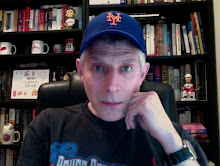The Jets, having stunned the world with their Super Bowl III triumph over the Baltimore Colts in 1969, paid a heavy karmic price for quarterback Joe Namath's victory guarantee and never posted a winning season.
 |
| All-purpose back Bruce Harper and offensive lineman Marvin Powell |
Hobbled by injuries, Namath's decline was precipitous and, by 1977, he was placed on waivers and claimed by the Los Angeles Rams. A succession of successors to championship coach Weeb Ewbank, failed to stem the losing tide.
The Giants' humiliating nadir came on a November day in 1978 when running back Larry Csonka, playing out the string in Hackensack, NJ after a hall of fame career in Miami, failed to corral quarterback Joe Pisarcik's handoff with less than 30 seconds remaining.
The ensuing fumble, scooped up and run into the Giants' end zone by Philadelphia Eagles linebacker Herman Edwards, converted a sure 17-12 victory into a 19-17 defeat.
The Jets, for good measure, lost by the same score that day, to the New England Patriots. They would finish the season 8-8, a five game improvement from the prior year, while the Giants would go 6-10. Each team would, bizarrely, replicate those records in 1979. Then, in 1980, each finished 4-12.
If there was a bright center of the pro football universe, New York was the planet it was farthest from.
But bad teams get good draft picks and, picking consecutively in the 1981 National Football League draft, the Giants selected hulking linebacker Lawrence Taylor as the second overall choice, while the Jets took the dazzling-if-fragile halfback Freeman McNeil as the third.
 |
| ... vs. the Packers, Dec. 20, 1981 An NY win would send the Jets and the Giants to the post-season. |
From there, the Jets took off. Buoyed by the gutsy play of quarterback Richard Todd and a ferocious defensive line -- Mark Gastineau, Abdul Salaam, Marty Lyons and Joe Klecko, a unit that collectively came to be known as the New York Sack Exchange -- Gang Green reeled off seven victories in nine games.
Among them, a stunning 16-15 victory over the division rival Miami Dolphins in which Todd, playing with a cracked rib and sprained ankle, threw a game winning touchdown to tight end Jerome Barkum with just seconds to spare.
By Dec. 20, the last Sunday of the regular season, the 9-5-1 Jets were scheduled to play the Green Bay Packers. On the line: a berth in the American Football Conference Wild Card game.
The Giants' seesaw season saw them win three in a row twice, while enduring a 1-3 stretch in between. Their regular season had ended the day before with a 13-10 victory over the Dallas Cowboys. With a 9-7 record, they needed help to make the post season. They needed the Jets to beat Green Bay.
And the Jets delivered. With Todd tossing two TDs, running backs Bruce Harper and Kevin Long adding two more and the defense sacking GB QB Lynn Dickey nine times, they dispatched the Packers, 28-3.
Christmas had come early. New York's wallflower football teams were going to the Wild Card dance. With both games set for Dec. 27, the Giants would journey to Philadelphia, while the Jets would host the Buffalo Bills at Shea.
 |
| The only NFL playoff game ever played at Shea Dec. 27, 1981 |
Harper fumbled his return of the opening kickoff. Sixteen seconds in, the visitors led 7-0. By the second quarter, Buffalo increased that lead to 24-0. The New Yorkers fought back, posting 13 unanswered points before the Bills struck again.
As the game clock wound down, Buffalo had the lead, 31-27, but the Jets had the ball and Todd was driving. With 10 seconds remaining, Bills defensive back Bill Simpson intercepted a pass at the one yard line, sealing the victory for the visitors.
It would be the only NFL playoff game ever played at Shea.* In 1984, they'd join the Giants at the Meadowlands. Meanwhile, down the interstate in Philadelphia, the future landlords beat the Eagles 27-21. Their season would end on Jan. 5 with a 38-24 loss to the eventual Super Bowl XVII winner San Francisco 49ers.
But the dreadful decade, 1970-1980, was over. Todd and the Jets would lose the 1982 AFC championship to the Dolphins in a mud-mired game in Miami. The Giants, in 1986, would beat the Denver Broncos to win Super Bowl XXI.
_______________________________
* To be sure, Shea hosted two American Football League Jets playoff games in 1968 and 1969.
-- Follow me on Twitter @paperboyarchive





































